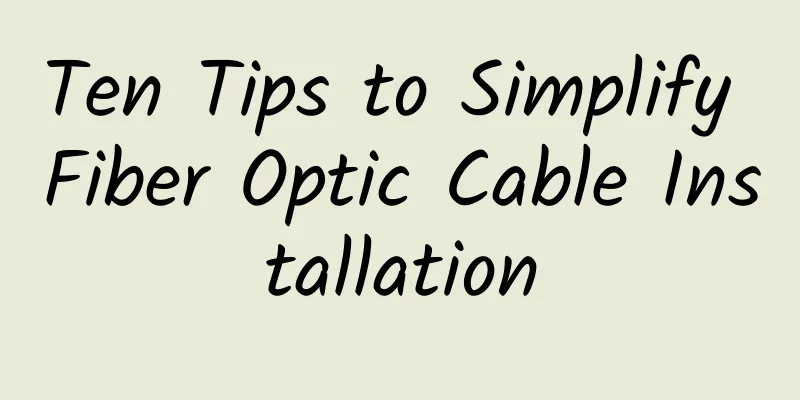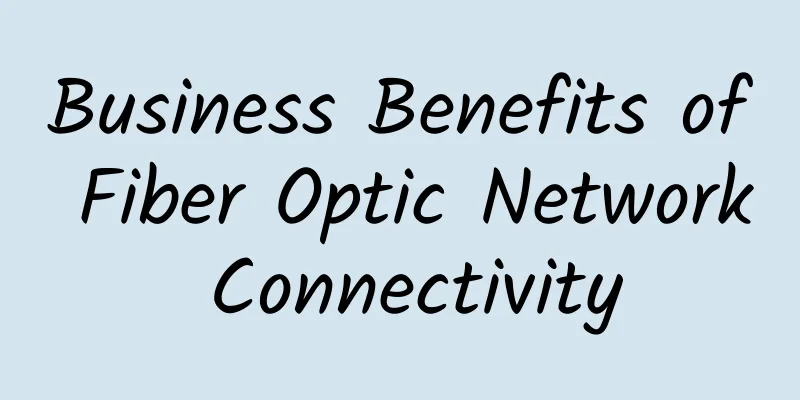Ten Tips to Simplify Fiber Optic Cable Installation

1. Plan aheadBefore beginning any fiber optic cable installation, proper planning and preparation are important. This includes mapping the cable route, identifying potential obstructions, and obtaining the necessary permits or approvals. It’s also important to consider factors such as the type of cable, connectors, and equipment required for the installation. Having a thorough plan will ensure that the installation process goes smoothly and that potential problems are identified and resolved before they occur. It’s also important to conduct a site survey to ensure there is enough space to install the cable and to check for any underground utilities or other potential hazards. Additionally, be sure to have a detailed testing plan in place to test the cable after it’s installed to ensure the system is working properly. Proper planning and preparation can save time, money, and potential headaches in the long run. 2. Choose the right cableFiber optic cables are an essential part of modern telecommunications infrastructure. However, it is important to note that not all fiber optic cables are the same. Different cables have different properties and are designed for specific use cases. When selecting a cable for a specific application, it is important to consider the environment in which it will be installed. For example, if the cable is going to be installed outdoors, it is important to choose a cable that is rated for outdoor use. This type of cable typically has a rugged jacket that can withstand extreme temperatures, humidity, and other weather conditions. It can also resist damage from factors such as UV radiation, water, and chemical exposure. It is also important to consider the temperature rating of the cable. It will be exposed to different temperature ranges, such as cold or hot environments. Cables designed for extreme temperatures will have a higher temperature rating than cables designed for indoor use. Additionally, the humidity rating of the cable must be considered. Fibers in high humidity environments are exposed to water vapor, which can damage the fibers. Therefore, it is important to select a cable with a high humidity rating if you are installing in a high humidity environment. 3. Use the right toolsHaving the right tools is essential for a successful fiber optic cable installation. This includes things like cable cutters, wire strippers and cleavers, and any other specialized tools that may be required. Using the right tools will make the installation process easier and ensure that the cables are properly prepared and connected. It is also important to use high-quality tools to ensure that the installation is completed correctly and efficiently. Poor quality tools can damage the fiber optic cable, causing performance degradation and signal loss. Using the right tools also helps reduce the risk of injury during the installation process. It is also important to use the correct tools for the specific type of fiber optic cable being installed, as different types of fiber may require different tools or procedures. 4. Protect the cableIt is very important to protect the fiber optic cables during the installation process. This includes using protective sleeves or conduit to protect the cables from damage and not bending or kinking the cables. Damaged cables can cause serious problems such as signal loss or complete system failure. 5. Test cableBefore and after installation, it is important to test the cable to ensure it is working properly. This includes continuity and signal strength testing, as well as any other tests that may be required. Regular cable testing can help detect any problems early so they can be resolved quickly and effectively. 6. Notes on underground installationUnderground fiber optic cable installation also presents its own set of challenges. These include identifying the location of buried utilities and taking care not to damage them during installation. It is also important to consider the type of conduit or sheathing required for underground installations to protect the cables and components from damage. 7. Use the correct splicing techniqueSplicing is a critical step in the fiber optic cable installation process. To ensure a safe and reliable connection, it is important to use the correct splicing technique, such as fusion splicing. Improper splicing can result in signal loss and weak connections, which can lead to system failures. Fusion splicing is considered one of the most accurate and reliable methods of fiber optic cable splicing. This process involves using heat to fuse or melt the ends of two fibers together to form a permanent connection. This method ensures low-loss and high-quality splices, resulting in minimal signal loss and a secure connection. In addition, using proper cutting techniques, such as precision cutting, before splicing can also greatly improve the quality of the splicing. It is also important to use the proper equipment, such as fusion splicers and cleavers, and have well-trained operators to ensure that the splicing process is completed correctly. In summary, the correct splicing techniques, equipment, and well-trained operators are essential for safe and reliable connections during fiber optic cable installation. 8. Use the right connectorSelecting the correct connector is critical to a successful fiber optic cable installation. Not only is it important to ensure that the connector is compatible with the cable and equipment being used, but it is also very important to select connectors that have low insertion loss and back reflections. Using incompatible connectors can result in signal loss, system failures, and overall network degradation. Researching and investing in high-quality connectors is important to ensure a reliable, efficient fiber optic cable installation. Additionally, proper installation and testing of connectors is essential to maintaining a successful fiber optic cable system. 9. Follow safety guidelinesSafety should always be a top priority when installing fiber optic cable. This includes things like proper grounding and bonding and taking care to avoid contact with live circuits. It is also important to follow OSHA regulations and guidelines to ensure the safety of the installer and any individuals who may come into contact with the cable in the future. 10. Hire professionalsIf you have no experience with fiber optic cable installation, it is best to hire a professional to handle the task. Not only will they have the knowledge and expertise to complete the job correctly, but they will also be able to handle any unforeseen problems that may arise. Additionally, hiring a professional can save time and resources in the long run because they will have the necessary tools, equipment, and expertise to complete the installation quickly and efficiently. SummarizeIn summary, installing fiber optic cable is complex and time-consuming, but following these 10 tips can simplify the process and make it more efficient. Proper planning and preparation, selecting the right cable, using the right tools, protecting the cable, regular testing, paying attention to underground installation, proper splicing techniques, selecting the right connectors, following safety guidelines, and hiring a professional when necessary will ensure a successful fiber optic cable installation. Remember, executing a good installation process is essential to ensure that the fiber optic cable is installed correctly and functions properly. FAQQ: What must I consider when choosing a fiber optic cable?A: When selecting fiber optic cable, it is important to consider the environment in which it will be installed, such as whether it will be installed outdoors or in extreme temperatures. If it will be exposed to extreme temperatures, it is important to select a cable that is suitable for outdoor use or has a high temperature rating. In addition, the humidity rating of the cable must also be considered, as optical fibers in high humidity environments will be exposed to water vapor, which may cause damage to the fiber. Q: Why is proper planning and preparation so important before installing fiber optic cables?A: Proper planning and preparation before installing fiber optic cables is critical to ensuring that the cables are installed correctly and function properly. This includes mapping the cable route, identifying potential obstructions, and obtaining necessary permits or approvals. It is also important to consider factors such as the type of cables, connectors, and equipment required for the installation. Having a thorough plan will ensure that the installation process goes smoothly and that potential problems are identified and resolved before they occur. Proper planning will also help reduce the risk of damage that could lead to expensive repairs or even complete replacement. Q: How does having the right tools help during installation?A: Using the correct tools during the installation process is critical to successfully installing fiber optic cables. This includes things like cable cutters, wire strippers and cutters, and any other specialized tools that may be required. Using the correct tools will make the installation process easier and ensure that the cables are properly prepared and connected. Additionally, using the correct tools will help reduce the risk of injury during the installation process. Q: How does correct splicing technology ensure safe and reliable connections during fiber optic cable installation?A: The splicing process is an essential part of fiber optic cable installation as it connects two separate optical fibers. If not done properly, splicing can result in signal loss and weak connections, which can lead to system failure. One of the most effective and reliable splicing techniques is fusion splicing, which uses heat to fuse or melt the ends of two optical fibers together to form a permanent connection. This method guarantees high-quality splices and minimal signal loss, resulting in a safe and reliable connection. To ensure the best results, it is important to use proper cutting techniques and equipment, such as splicers and cleavers, and have trained operators perform the splicing process. Q: Why is choosing the right connector important?A: Selecting the correct connector is critical to the successful installation of fiber optic cable because it ensures compatibility with the cables and equipment used as well as low insertion loss and back reflection. Using incompatible connectors can result in signal loss, system failures, and overall network performance degradation. Researching and investing in high-quality connectors is important to ensure reliable and efficient fiber optic cable installation. Additionally, proper installation and testing of connectors is essential to maintaining a successful fiber optic cable system. |
<<: Six key advantages of optical interconnect technology
>>: How fiber optic networks can create more efficient and secure connections
Recommend
An article to help you understand HTML5 MathML
[[347913]] HTML5 can use MathML elements in docum...
What does the TTL value returned by the Ping command mean and what does it do?
The ping command is used to test the connection t...
Huawei's 3GPP 5G pre-commercial system wins the World Internet Leading Technology Achievement Award
[Wuzhen, China, December 3, 2017] Recently, the w...
F5 Networks Appoints Adam Judd to Lead APAC Sales Efforts to Accelerate Growth of Cloud and Security Business in the Region
Beijing, March 21, 2017 – Today, F5 Networks anno...
Three tips for solving bandwidth issues in small government offices
In the wake of the pandemic lockdown, many govern...
Why do we need 5G-A?
In today's article, I want to talk to you abo...
Before becoming a "hacker", you must master the "network protocol port"
In the previous article, we gave a detailed descr...
Learn about MQTT protocol in one article
Today we will talk about the MQTT protocol in det...
The router is not to blame for the slow WiFi connection. Look at the receiving end.
The Year of the Rooster has arrived! Good luck to...
Research and application of 3D-MIMO antenna weight optimization method based on MDT
Labs Guide This paper proposes a method to optimi...
[11.11] iOVZ: 60% off monthly payment/50% off annual payment for all VPS/dedicated servers, Hong Kong/Korea VPS monthly payment starts from 36 yuan
iOVZ Cloud has launched a promotion during the 20...
How DevOps is shaping the future of networking
Since its advent in 2009, the DevOps philosophy h...
Ministry of Industry and Information Technology: In the first four months, my country's telecommunications business revenue totaled 486.2 billion yuan, a year-on-year increase of 6.6%
[[400860]] According to the latest data released ...
It may take another five to ten years for IPv6 to completely replace IPv4
[[329716]] On June 6, 2012, World IPv6 Launch, ma...
5 reasons why DevOps will be a big thing in 2018
DevOps has been a hot topic for a few years now. ...









